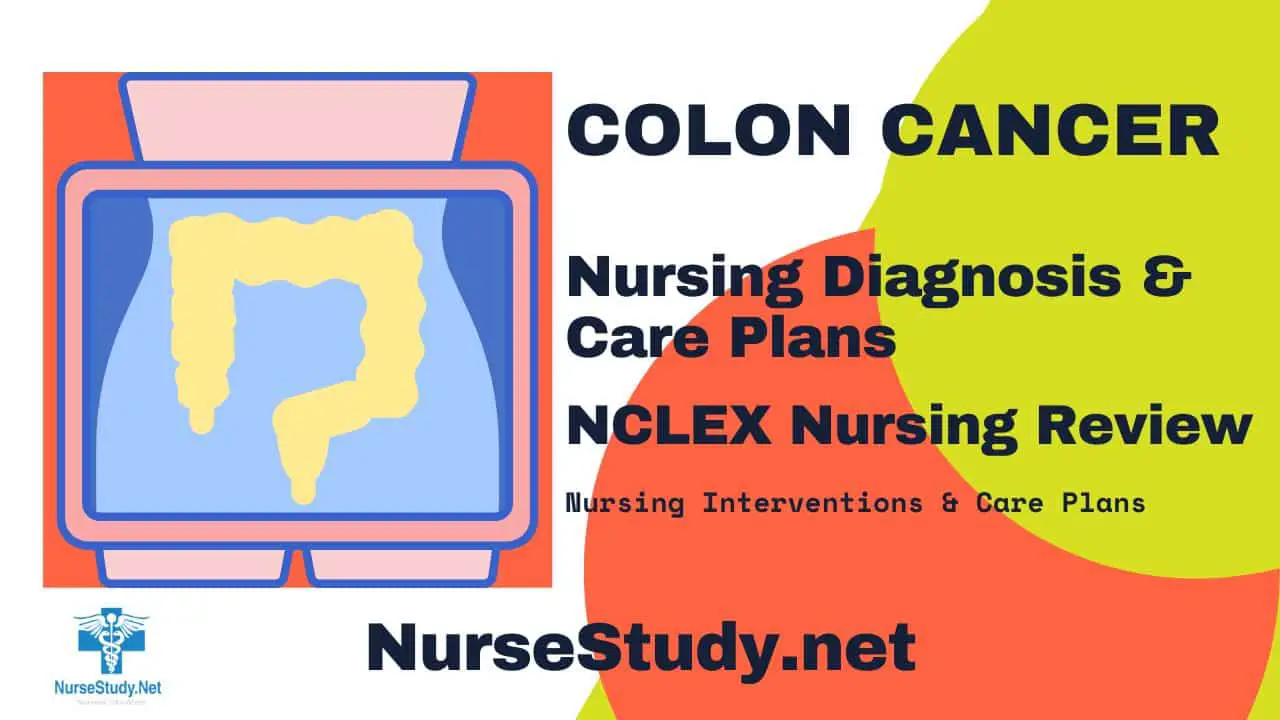Colon cancer nursing diagnosis requires a thorough understanding of the disease process, patient assessment, and the implementation of evidence-based nursing interventions. This comprehensive guide explores the essential nursing diagnoses, interventions, and care plans for colon cancer patients.
Overview of Colon Cancer
Colon cancer develops when abnormal cells in the large intestine grow uncontrollably, forming malignant tumors. Understanding the disease process is crucial for developing appropriate nursing diagnoses and care plans. Risk factors include age over 50, family history, inflammatory bowel disease, obesity, smoking, and poor dietary habits.
Nursing Assessment
Physical Assessment
Abdominal examination
- Inspect for visible masses or distention
- Palpate for tenderness or masses
- Assess bowel sounds
- Check for hepatomegaly
Vital signs monitoring
- Temperature for infection
- Blood pressure for complications
- Pain assessment
Nutritional status
- Weight changes
- Appetite
- Dietary intake
Diagnostic Procedures
Laboratory tests
- Complete blood count
- Tumor markers
- Liver function tests
Imaging studies
- CT scan
- MRI
- PET scan
- Colonoscopy results
Nursing Diagnoses and Care Plans
1. Acute Pain
Nursing Diagnosis Statement:
Acute pain related to tumor growth, surgical intervention, and treatment side effects as evidenced by verbal reports of pain, grimacing, and protective behavior.
Related Factors/Causes:
- Tumor mass effect
- Post-surgical discomfort
- Chemotherapy side effects
- Radiation therapy effects
Nursing Interventions and Rationales:
Perform comprehensive pain assessment
- Rationale: Ensures appropriate pain management strategy
Administer prescribed pain medications
- Rationale: Provides relief and improves comfort
Implement non-pharmacological pain management
- Rationale: Complements medication therapy and promotes comfort
Monitor pain relief effectiveness
- Rationale: Allows for timely intervention modifications
Desired Outcomes:
- The patient reports pain at an acceptable level
- The patient demonstrates improved functional ability
- The patient uses pain management strategies effectively
2. Impaired Nutritional Status
Nursing Diagnosis Statement:
Impaired nutritional status related to disease process and treatment effects as evidenced by weight loss, decreased appetite, and altered metabolic state.
Related Factors/Causes:
- Decreased appetite
- Treatment side effects
- Metabolic changes
- Malabsorption
Nursing Interventions and Rationales:
Monitor nutritional intake
- Rationale: Identifies deficiencies and guides interventions
Collaborate with dietitian
- Rationale: Ensures appropriate nutritional support
Implement dietary modifications
- Rationale: Promotes optimal nutrition
Monitor weight and laboratory values
- Rationale: Tracks nutritional status
Desired Outcomes:
- The patient maintains a stable weight
- The patient demonstrates improved appetite
- The patient meets nutritional requirements
3. Risk for Infection
Nursing Diagnosis Statement:
Risk for infection related to immunosuppression from chemotherapy and surgical intervention.
Related Factors/Causes:
- Compromised immune system
- Surgical procedures
- Invasive procedures
- Nutritional deficits
Nursing Interventions and Rationales:
Implement infection control measures
- Rationale: Prevents infection transmission
Monitor for signs of infection
- Rationale: Enables early detection and treatment
Educate about infection prevention
- Rationale: Promotes self-care and prevention
Administer prescribed antibiotics
- Rationale: Treats or prevents infection
Desired Outcomes:
- The patient remains free from infection
- Patient demonstrates infection prevention techniques
- Patient identifies early signs of infection
4. Anxiety
Nursing Diagnosis Statement:
Anxiety related to diagnosis, treatment process, and uncertain prognosis as evidenced by expressed concerns and increased tension.
Related Factors/Causes:
- Disease diagnosis
- Treatment uncertainties
- Fear of death
- Family role changes
Nursing Interventions and Rationales:
Provide emotional support
- Rationale: Reduces anxiety and promotes coping
Educate about the disease process
- Rationale: Increases understanding and control
Facilitate support system involvement
- Rationale: Enhances coping mechanisms
Implement relaxation techniques
- Rationale: Reduces stress and anxiety
Desired Outcomes:
- The patient demonstrates reduced anxiety
- The patient uses effective coping strategies
- Patient verbalizes understanding of the condition
5. Impaired Skin Integrity
Nursing Diagnosis Statement:
Impaired skin integrity related to surgical intervention and treatment effects as evidenced by wound presence and altered skin condition.
Related Factors/Causes:
- Surgical procedures
- Radiation therapy
- Nutritional deficits
- Immobility
Nursing Interventions and Rationales:
Perform wound care
- Rationale: Promotes healing and prevents complications
Monitor skin condition
- Rationale: Identifies changes requiring intervention
Implement pressure relief measures
- Rationale: Prevents skin breakdown
Provide nutritional support
- Rationale: Supports wound healing
Desired Outcomes:
- Patient demonstrates wound healing
- The patient maintains skin integrity
- The patient performs proper skincare
References
- Ackley, B. J., Ladwig, G. B., Makic, M. B., Martinez-Kratz, M. R., & Zanotti, M. (2023). Nursing diagnoses handbook: An evidence-based guide to planning care. St. Louis, MO: Elsevier.
- Brouwer NPM, Bos ACRK, Lemmens VEPP, Tanis PJ, Hugen N, Nagtegaal ID, de Wilt JHW, Verhoeven RHA. An overview of 25 years of incidence, treatment and outcome of colorectal cancer patients. Int J Cancer. 2018 Dec 1;143(11):2758-2766. doi: 10.1002/ijc.31785. Epub 2018 Sep 29. PMID: 30095162; PMCID: PMC6282554.
- Harding, M. M., Kwong, J., & Hagler, D. (2022). Lewis’s Medical-Surgical Nursing: Assessment and Management of Clinical Problems, Single Volume. Elsevier.
- Herdman, T. H., Kamitsuru, S., & Lopes, C. (2024). NANDA International Nursing Diagnoses – Definitions and Classification, 2024-2026.
- Ignatavicius, D. D., Rebar, C., & Heimgartner, N. M. (2023). Medical-Surgical Nursing: Concepts for Clinical Judgment and Collaborative Care. Elsevier.
- Miao J, Liu M, Ma J, Wang H. Effectiveness of Comfort Nursing Combined with Continuous Nursing on Patients with Colorectal Cancer Chemotherapy. Evid Based Complement Alternat Med. 2022 Jun 8;2022:9647325. doi: 10.1155/2022/9647325. PMID: 35722154; PMCID: PMC9200510.
- Silvestri, L. A. (2023). Saunders comprehensive review for the NCLEX-RN examination. St. Louis, MO: Elsevier.
- Zhang A, Fu H. The Impact of Palliative Care and Nursing Intervention on the Psychology and Quality of Life of Elderly Patients with Colorectal Cancer. J Oncol. 2022 Jun 13;2022:7777446. doi: 10.1155/2022/7777446. PMID: 35734225; PMCID: PMC9208981.
